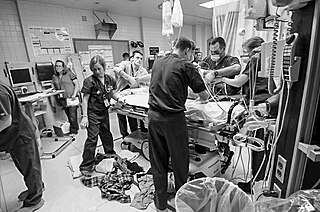
Emergency medicine is the medical speciality concerned with the care of illnesses or injuries requiring immediate medical attention. Emergency medicine physicians specialize in providing care for unscheduled and undifferentiated patients of all ages. As first-line providers, in coordination with emergency medical services, they are primarily responsible for initiating resuscitation and stabilization and performing the initial investigations and interventions necessary to diagnose and treat illnesses or injuries in the acute phase. Emergency medical physicians generally practice in hospital emergency departments, pre-hospital settings via emergency medical services, and intensive care units. Still, they may also work in primary care settings such as urgent care clinics.

Emergency medical services (EMS), also known as ambulance services or paramedic services, are emergency services that provide urgent pre-hospital treatment and stabilisation for serious illness and injuries and transport to definitive care. They may also be known as a first aid squad, FAST squad, emergency squad, ambulance squad, ambulance corps, life squad or by other initialisms such as EMAS or EMARS.

Osteopathy, unlike osteopathic medicine, which is a branch of the medical profession in the United States, is a pseudoscientific system of alternative medicine that emphasizes physical manipulation of the body's muscle tissue and bones. In most countries, practitioners of osteopathy are not medically trained and are referred to as osteopaths.

A paramedic is a healthcare professional trained in the medical model, whose main role has historically been to respond to emergency calls for medical help outside of a hospital. Paramedics work as part of the emergency medical services (EMS), most often in ambulances. They also have roles in emergency medicine, primary care, transfer medicine and remote/offshore medicine. The scope of practice of a paramedic varies between countries, but generally includes autonomous decision making around the emergency care of patients.
Osteopathic medicine is a branch of the medical profession in the United States that promotes the practice of science-based medicine, often referred to in this context as allopathic medicine, with a set of philosophy and principles set by its earlier form, osteopathy. Osteopathic physicians (DOs) are graduates of American osteopathic medical colleges and are licensed to practice the full scope of medicine and surgery in all 50 U.S. states. The field is distinct from osteopathic practices offered in nations outside of the U.S.—in which practitioners are generally considered neither parts of core medical staff nor of medicine itself; rather, they are considered alternative medicine practitioners. The other major branch of medicine in the United States is referred to by practitioners of osteopathic medicine as allopathic medicine.

An emergency physician is a physician who works in an emergency department to care for ill patients. The emergency physician specializes in advanced cardiac life support, resuscitation, trauma care such as fractures and soft tissue injuries, and management of other life-threatening situations.
A medical director is a physician who provides guidance and leadership on the use of medicine in a healthcare organization. These include the emergency medical services, hospital departments, blood banks, clinical teaching services, and others. A medical director devises the protocols and guidelines for the clinical staff and evaluates them while they are in use.
The University of North Texas Health Science Center at Fort Worth – HSC, Health Science Center, Health Science Center at Fort Worth – is an academic health science center in Fort Worth, Texas. It is part of the University of North Texas System and was founded in 1970 as the Texas College of Osteopathic Medicine, with its first cohort graduating in 1974. The Health Science Center consists of six schools with a total enrollment of 2,338 students (2022-23).

The American Osteopathic Association (AOA) is the representative member organization for the more than 197,000 osteopathic medical doctors (D.O.s) and osteopathic medical students in the United States. The AOA is headquartered in Chicago, Illinois, and is involved in post-graduate training for osteopathic physicians. Beginning in 2015, it began accrediting post-graduate education as a committee within the Accreditation Council for Graduate Medical Education, creating a unified accreditation system for all DOs and MDs in the United States. The organization promotes public health, encourages academic scientific research, serves as the primary certifying body for D.O.s overseeing 18 certifying boards, and is the accrediting agency for osteopathic medical schools through its Commission on Osteopathic College Accreditation. As of October 2015, the AOA no longer owns the Healthcare Facilities Accreditation Program (HFAP), which accredited hospitals and other health care facilities.

Philadelphia College of Osteopathic Medicine (PCOM) is a private medical school with its main campus in Philadelphia, Pennsylvania, and additional locations in Suwanee, Georgia and Moultrie, Georgia.
Tyler C. Cymet is a physician in Baltimore, Maryland. Cymet attended Emory University for his premedical undergraduate degree and majored in psychology and anthropology. He then attended medical school at Nova Southeastern University College of Osteopathic Medicine to acquire his medical degree, served as an intern at the Midwestern University Graduate Medical Education system, performed a Primary Care Internal Medicine residency at Yale University, and did additional training at Sinai Hospital of Baltimore.

In the United States, the paramedic is an allied health professional whose primary focus is to provide advanced emergency medical care for patients who access Emergency Medical Services (EMS). This individual possesses the complex knowledge and skills necessary to provide patient care and transportation. Paramedics function as part of a comprehensive EMS response under physician medical direction. Paramedics often serve in a prehospital role, responding to Public safety answering point (9-1-1) calls in an ambulance. The paramedic serves as the initial entry point into the health care system. A standard requirement for state licensure involves successful completion of a nationally accredited Paramedic program at the certificate or associate degree level.
Touro University Nevada (TUN) is a private university in Henderson, Nevada. It is part of the Touro College and University System. Touro University Nevada is a branch campus of its sister campus Touro University California.

Kansas City University (KCU) is a private medical school with its main campus in Kansas City, Missouri and an additional campus in Joplin, Missouri. Founded in 1916, KCU is one of the original osteopathic medical schools in the United States. It consists of both a College of Osteopathic Medicine and a College of Biosciences. KCU is one of the largest medical schools in the nation by enrollment.
Most physicians in the United States hold either the Doctor of Medicine degree (MD) or the Doctor of Osteopathic Medicine degree (DO). Institutions awarding the MD are accredited by the Liaison Committee on Medical Education (LCME). Institutions awarding the DO are accredited by the Commission on Osteopathic College Accreditation (COCA). The World Directory of Medical Schools lists both LCME accredited MD programs and COCA accredited DO programs as US medical schools. Foreign-trained osteopaths do not hold DO degrees and are not recognized as physicians in the United States or in other jurisdictions.
Doctor of Osteopathic Medicine is a medical degree conferred by the 38 osteopathic medical schools in the United States. DO and Doctor of Medicine (MD) degrees are equivalent: a DO graduate may become licensed as a physician or surgeon and thus have full medical and surgical practicing rights in all 50 US states. As of 2023, there were 186,871 osteopathic physicians and medical students in DO programs across the United States. Osteopathic medicine emerged historically from the quasi-medical practice of osteopathy, but has become a distinct and proper medical profession.
The Federation of State Medical Boards (FSMB) of the United States is a national non-profit organization that represents the 71 state medical and osteopathic boards of the United States and its territories and co-sponsors the United States Medical Licensing Examination. Medical boards license physicians, investigate complaints, discipline those who violate the law, conduct physician evaluations, and facilitate the rehabilitation of physicians where appropriate. The FSMB's mission calls for "continual improvement in the quality, safety and integrity of health care through the development and promotion of high standards for physician licensure and practice."

State Medical Rescue in Poland is a system of free public emergency healthcare established by Ustawa o Państwowym Ratownictwie Medycznym, including ambulance service and Emergency Departments (EDs). While in Polish public hospitals and clinics NFZ common public insurance is required, PRM medical services in ambulances and EDs are completely free for everyone. Since 2018 emergency ambulances that operates in PRM, that is Polish 112 and 999 emergency numbers, are operated by public entities only.
The Burrell College of Osteopathic Medicine(BCOM) is a private, for-profit medical school. The main campus is located on the New Mexico State University (NMSU) campus in Las Cruces, New Mexico, and their second campus is located on the Florida Institute of Technology (FIT) campus in Melbourne, Florida. It is accredited by the American Osteopathic Association's Commission on Osteopathic College Accreditation and graduated its first class in May 2020.
Stephen Typaldos, D.O. was an American physician who was the founder of the Fascial Distortion Model, an anatomical and physiological model of medicine.









